Experimental Investigation of a Double-Acting Vane Pump with Integrated Electric Drive
Abstract
:1. Introduction
2. Design of the Novel Pump-Motor Assembly
3. Description of the Research Test Bench
4. Steady-State Tests of the Motor-Pump Assembly
5. Dynamic Testing of the Motor-Pump Assembly at Constant Rotational Speed and Pressure Changes
6. Dynamic Testing of the Motor-Pump Assembly at Constant Pressure and Changes in the Rotational Speed
7. Conclusions
8. Patents
Author Contributions
Funding
Conflicts of Interest
References
- Ivantysyn, J.; Ivantysynova, M. Hydrostatic Pumps and Motors: Principles, Design, Performance, Modelling, Analysis, Control and Testing; Tech Books International: New Delhi, India, 2003. [Google Scholar]
- Brusiani, F.; Bianchi, G.; Costa, M.; Squarcini, R.; Gasperini, M. Analysis of Air/Cavitation Interaction inside a Rotary Vane Pump for Application on Heavy Duty Engine; SAE Technical Paper 2009-01-1943; SAE International: Warrendale, PA, USA, 2009. [Google Scholar]
- Sullivan, P.; Sehmby, M. Internal Force Analysis of a Variable Displacement Vane Pump; SAE Technical Paper 2012-01-0409; SAE International: Warrendale, PA, USA, 2012. [Google Scholar] [CrossRef]
- Frendo, F.; Novi, N.; Squarcini, R. Numerical and Experimental Analysis of Variable Displacement Vane Pumps. In Proceedings of the International Conference on Tribology, Parma, Italy, 20–22 September 2006. [Google Scholar]
- Inaguma, Y. Friction Characteristics of Vane for a Balanced Vane Pump. Trans. Jpn. Fluid Power Syst. Soc. 2014, 45, 58–65. [Google Scholar] [CrossRef] [Green Version]
- Fiebig, W.; Cependa, P.; Jędraszczyk, P.; Kuczwara, H. Innovative Solution of an Integrated Motor Pump Assembly. In Fluid Power Systems Technology; American Society of Mechanical Engineers: New York, NY, USA, 2017. [Google Scholar]
- Fiebig, W.; Dudzikowski, I.; Ciurys, M.; Hubert, K. A Vane Pump Integrated with an Electric Motor. In Proceedings of the 9th International Fluid Power Conference, IFK, Aachen, Germany, 9 March 2014. [Google Scholar]
- Fiebig, W.; Cependa, P.; Kuczwara, H.; Wang, F. Analysis of vane loads and motion in a hydraulic double vane pump with integrated electrical drive. Arch. Civ. Mech. Eng. 2021, 21, 1–15. [Google Scholar] [CrossRef]
- Motor/Pump Hybrid System EPAI for High and Medium- Pressure Application; Voith Brochure: Rutesheim, Germany, 2012.
- Almeida, A.; Ferreira, F.J.T.E.; Fong, J. Standards for Efficiency of Electric Motors. IEEE Ind. Appl. Mag. 2011, 17, 12–19. [Google Scholar] [CrossRef]
- De Almeida, A.T.; Ferreira, F.J.T.E.; Baoming, G. Beyond Induction Motors—Technology Trends to Move Up Efficiency. IEEE Trans. Ind. Appl. 2014, 50, 2103–2114. [Google Scholar] [CrossRef]
- Gieras, J.F. Permanent Magnet Motor Technology: Design and Applications, 3rd ed.; CRC Press: Boca Raton, FL, USA, 2009; ISBN 978-1-4200-6440-7. [Google Scholar]
- Hendershot, J.R.; Miller, T.J.E. Design of Brushless Permanent-Magnet Machines, 2nd ed.; Motor Design Books LLC: Venice, FL, USA, 2010; ISBN 978-0-9840687-0-8. [Google Scholar]
- Hughes, A. Electric Motors and Drives: Fundamentals, Types and Applications, 3rd ed.; Newnes: Amsterdam, NY, USA; Boston, MA, USA, 2006; ISBN 978-0-7506-4718-2. [Google Scholar]
- Seo, J.-M.; Rhyu, S.-H.; Kim, J.-H.; Choi, J.-H.; Jung, I.-S. Design of Axial Flux Permanent Magnet Brushless DC Motor for Robot Joint Module. In Proceedings of the 2010 International Power Electronics Conference ECCE ASIA, Sapporo, Japan, 21–24 June 2010; pp. 1336–1340. [Google Scholar]
- Yang, S.; Jung, Y.; Seo, J.; Lee, M.; Kim, J.-H. Numerical and Experimental Study on the Cooling Performance Affected by Ventilation Holes of a BLDC Motor for Multi-Copters. In Proceedings of the 2018 IEEE 18th International Power Electronics and Motion Control Conference, Budapest, Hungary, 26–30 August 2018; pp. 293–298. [Google Scholar] [CrossRef]
- Cao, W.; Mecrow, B.C.; Atkinson, G.J.; Bennett, J.W.; Atkinson, D.J. Overview of Electric Motor Technologies Used for More Electric Aircraft (MEA). IEEE Trans. Ind. Electron. 2012, 59, 3523–3531. [Google Scholar] [CrossRef]
- Carev, V.; Roháč, J.; Šipoš, M.; Schmirler, M. A Multilayer Brushless DC Motor for Heavy Lift Drones. Energies 2021, 14, 2504. [Google Scholar] [CrossRef]
- Chau, K.T.; Chan, C.C.; Liu, C. Overview of Permanent-Magnet Brushless Drives for Electric and Hybrid Electric Vehicles. IEEE Trans. Ind. Electron. 2008, 55, 2246–2257. [Google Scholar] [CrossRef] [Green Version]
- Liu, X.; Chen, H.; Zhao, J.; Belahcen, A. Research on the Performances and Parameters of Interior PMSM Used for Electric Vehicles. IEEE Trans. Ind. Electron. 2016, 63, 3533–3545. [Google Scholar] [CrossRef]
- Pellegrino, G.; Vagati, A.; Guglielmi, P.; Boazzo, B. Performance Comparison between Surface-Mounted and Interior PM Motor Drives for Electric Vehicle Application. IEEE Trans. Ind. Electron. 2011, 59, 803–811. [Google Scholar] [CrossRef] [Green Version]
- De Santiago, J.; Bernhoff, H.; Ekergård, B.; Eriksson, S.; Ferhatovic, S.; Waters, R.; Leijon, M. Electrical Motor Drivelines in Commercial All-Electric Vehicles: A Review. IEEE Trans. Veh. Technol. 2012, 61, 475–484. [Google Scholar] [CrossRef] [Green Version]
- Wang, J.; Yuan, X.; Atallah, K. Design Optimization of a Surface-Mounted Permanent-Magnet Motor with Concentrated Windings for Electric Vehicle Applications. IEEE Trans. Veh. Technol. 2013, 62, 1053–1064. [Google Scholar] [CrossRef]
- Yang, Z.; Shang, F.; Brown, I.P.; Krishnamurthy, M. Comparative Study of Interior Permanent Magnet, Induction, and Switched Reluctance Motor Drives for EV and HEV Applications. IEEE Trans. Transp. Electrif. 2015, 1, 245–254. [Google Scholar] [CrossRef]
- Yang, Y.-P.; Luh, Y.-P.; Cheung, C.-H. Design and Control of Axial-Flux Brushless DC Wheel Motors for Electric Vehicles—Part I: Multiobjective Optimal Design and Analysis. IEEE Trans. Magn. 2004, 40, 1873–1882. [Google Scholar] [CrossRef]
- Zeraoulia, M.; Benbouzid, M.E.H.; Diallo, D. Electric Motor Drive Selection Issues for HEV Propulsion Systems: A Comparative Study. IEEE Trans. Veh. Technol. 2006, 55, 1756–1764. [Google Scholar] [CrossRef] [Green Version]
- Xu, W.; Zhu, J.; Guo, Y.; Wang, S.; Wang, Y.; Shi, Z. Survey on Electrical Machines in Electrical Vehicles. In Proceedings of the 2009 International Conference on Applied Superconductivity and Electromagnetic Devices, Chengdu, China, 25–27 September 2009; pp. 167–170. [Google Scholar]
- Antaki, J.; Paden, B.; Piovoso, M.; Banda, S. Award-winning control applications. IEEE Control. Syst. Mag. 2002, 22, 8–19. [Google Scholar] [CrossRef]
- Piccigallo, M.; Scarfogliero, U.; Quaglia, C.; Petroni, G.; Valdastri, P.; Menciassi, A.; Dario, P. Design of a Novel Bimanual Robotic System for Single-Port Laparoscopy. IEEE/ASME Trans. Mechatron. 2010, 15, 871–878. [Google Scholar] [CrossRef] [Green Version]
- Lawson, B.E.; Mitchell, J.E.; Truex, D.; Shultz, A.H.; LeDoux, E.; Goldfarb, M. A Robotic Leg Prosthesis: Design, Control, and Implementation. IEEE Robot. Autom. Mag. 2014, 21, 70–81. [Google Scholar] [CrossRef]
- Yamashita, H.; Kim, D.; Hata, N.; Dohi, T. Multi-Slider Linkage Mechanism for Endoscopic Forceps Manipulator. In Proceedings of the 2003 IEEE/RSJ International Conference on Intelligent Robots and Systems (IROS 2003) (Cat. No.03CH37453), Las Vegas, NV, USA, 27–31 October 2003; Volume 3, pp. 2577–2582. [Google Scholar]
- Li, H.; Li, W.; Ren, H. Fault-Tolerant Inverter for High-Speed Low-Inductance BLDC Drives in Aerospace Applications. IEEE Trans. Power Electron. 2017, 32, 2452–2463. [Google Scholar] [CrossRef]
- Huang, X.; Goodman, A.; Gerada, C.; Fang, Y.; Lu, Q. Design of a Five-Phase Brushless DC Motor for a Safety Critical Aerospace Application. IEEE Trans. Ind. Electron. 2012, 59, 3532–3541. [Google Scholar] [CrossRef]
- Yoon, K.-Y.; Baek, S.-W. Robust Design Optimization with Penalty Function for Electric Oil Pumps with BLDC Motors. Energies 2019, 12, 153. [Google Scholar] [CrossRef] [Green Version]
- Ciurys, M.P. Electromagnetic phenomena analysis in brushless DC motor with speed control using PWM method. Open Phys. 2017, 15, 907–912. [Google Scholar] [CrossRef] [Green Version]
- Ciurys, M.P. Analysis of the Influence of Inverter PWM Speed Control Methods on the Operation of a BLDC Motor. Arch. Electr. Eng. 2018, 67, 939–953. [Google Scholar] [CrossRef]
- Ciurys, M.P.; Dudzikowski, I.; Pawlak, M. Laboratory tests of a PM-BLDC motor drive. In Proceedings of the 2015 Selected Problems of Electrical Engineering and Electronics (WZEE), Kielce, Poland, 17–19 September 2015; pp. 1–6. [Google Scholar] [CrossRef]



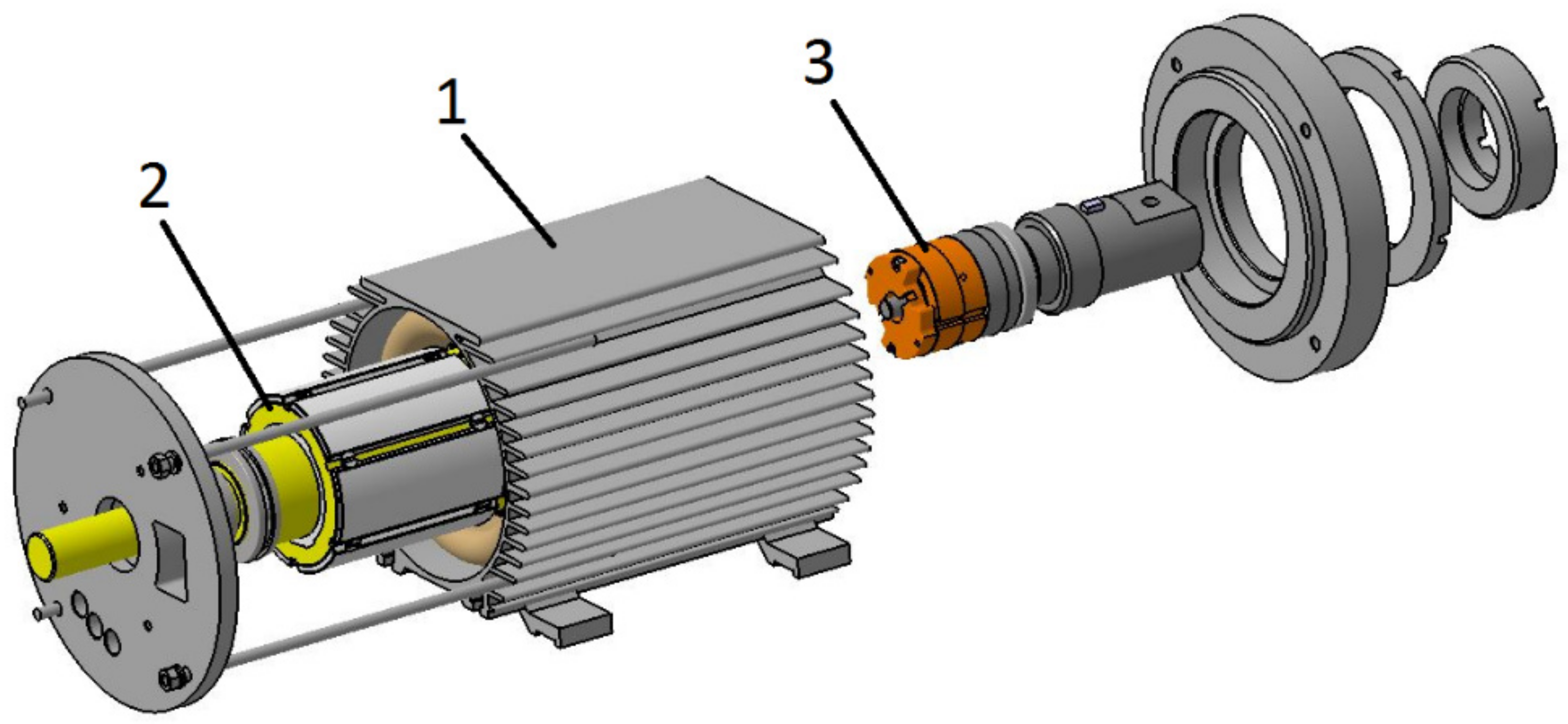
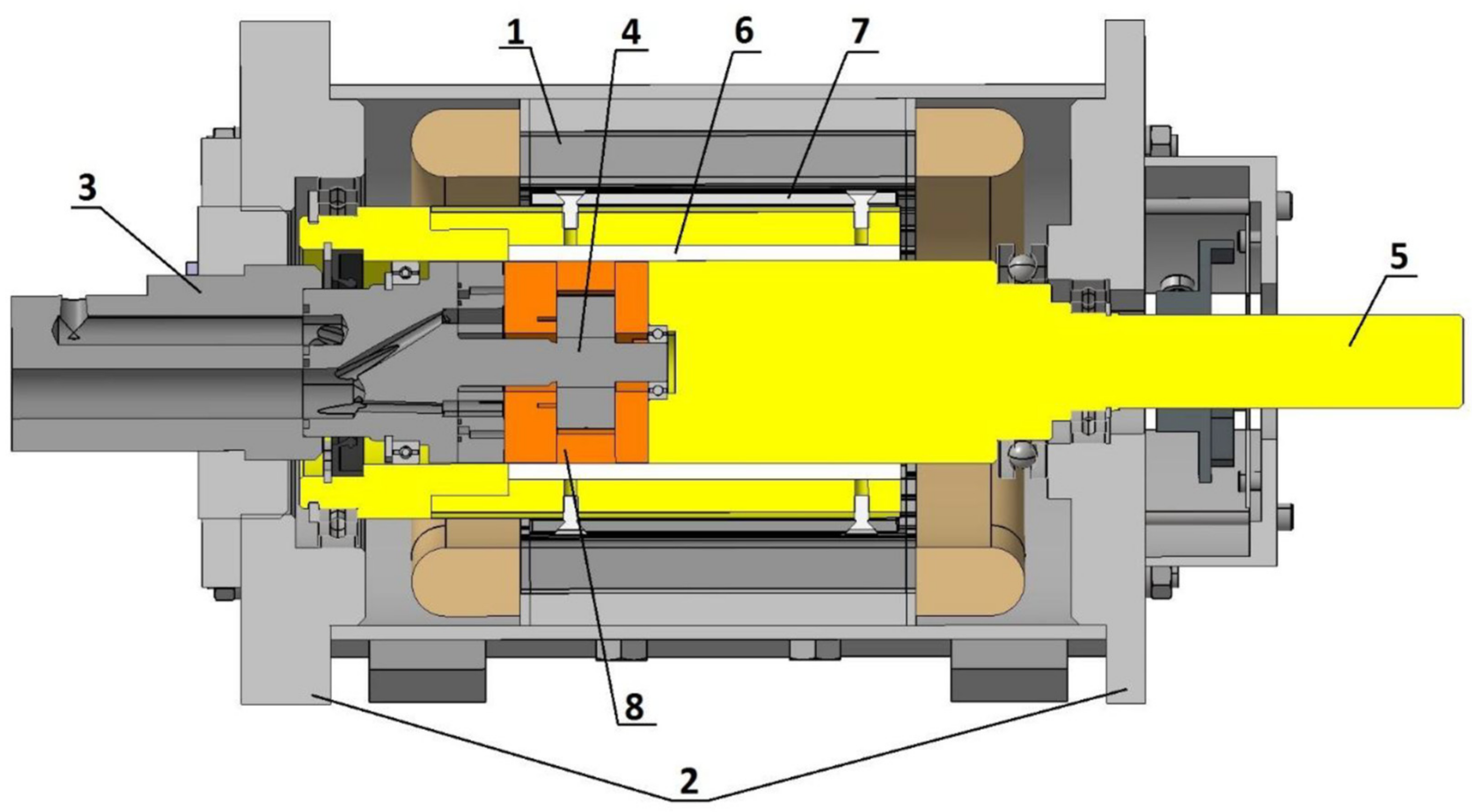

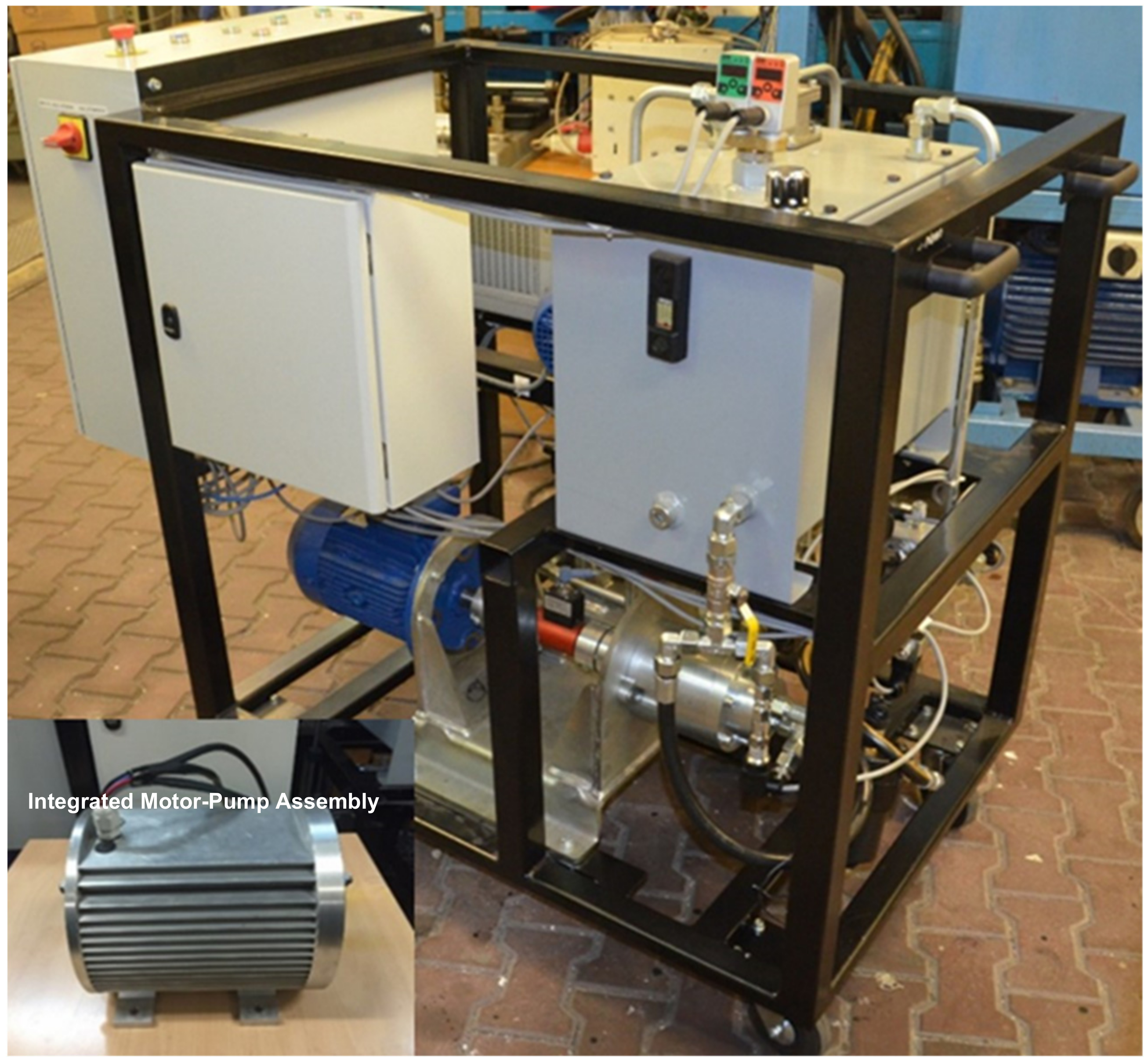
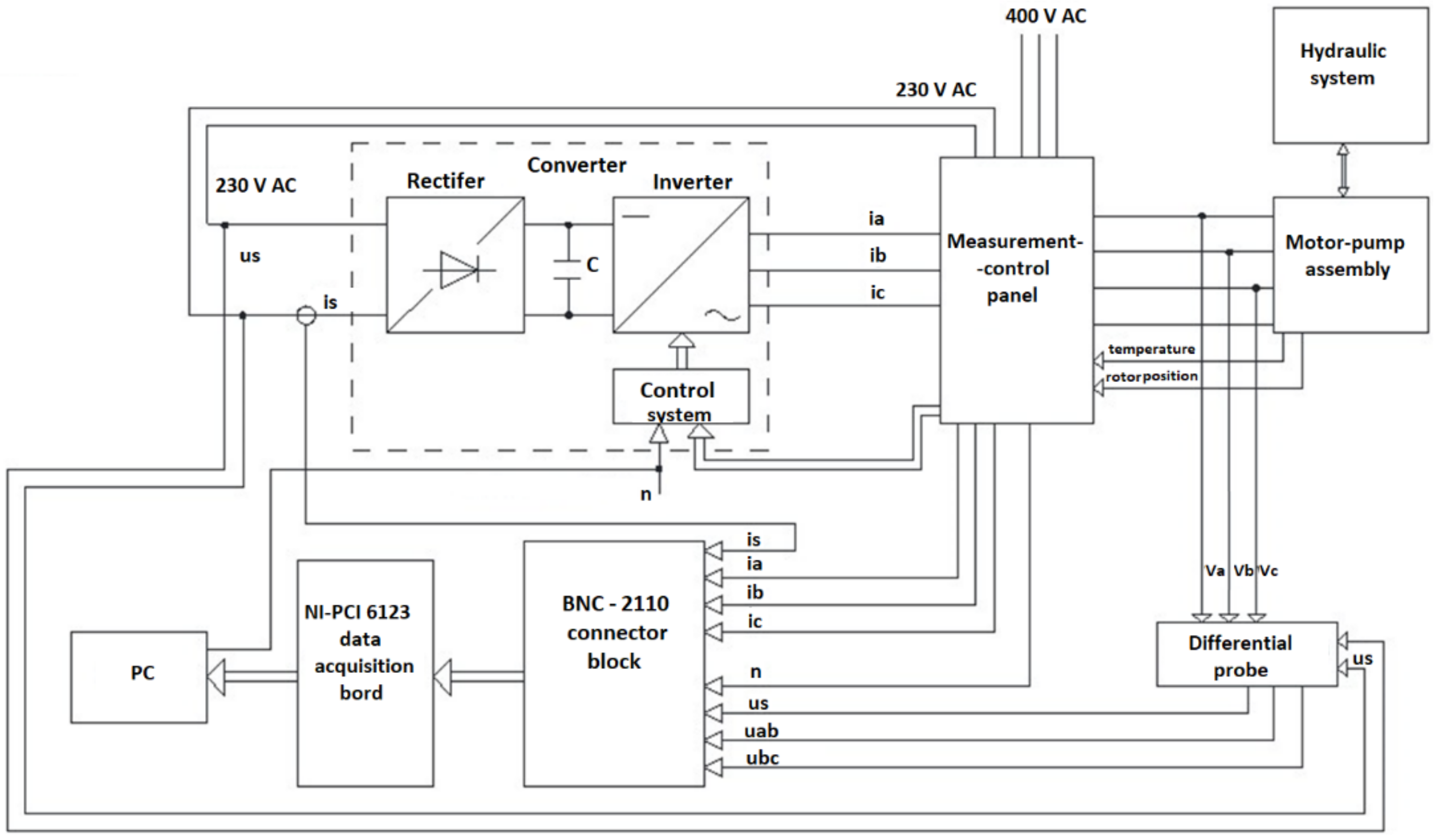

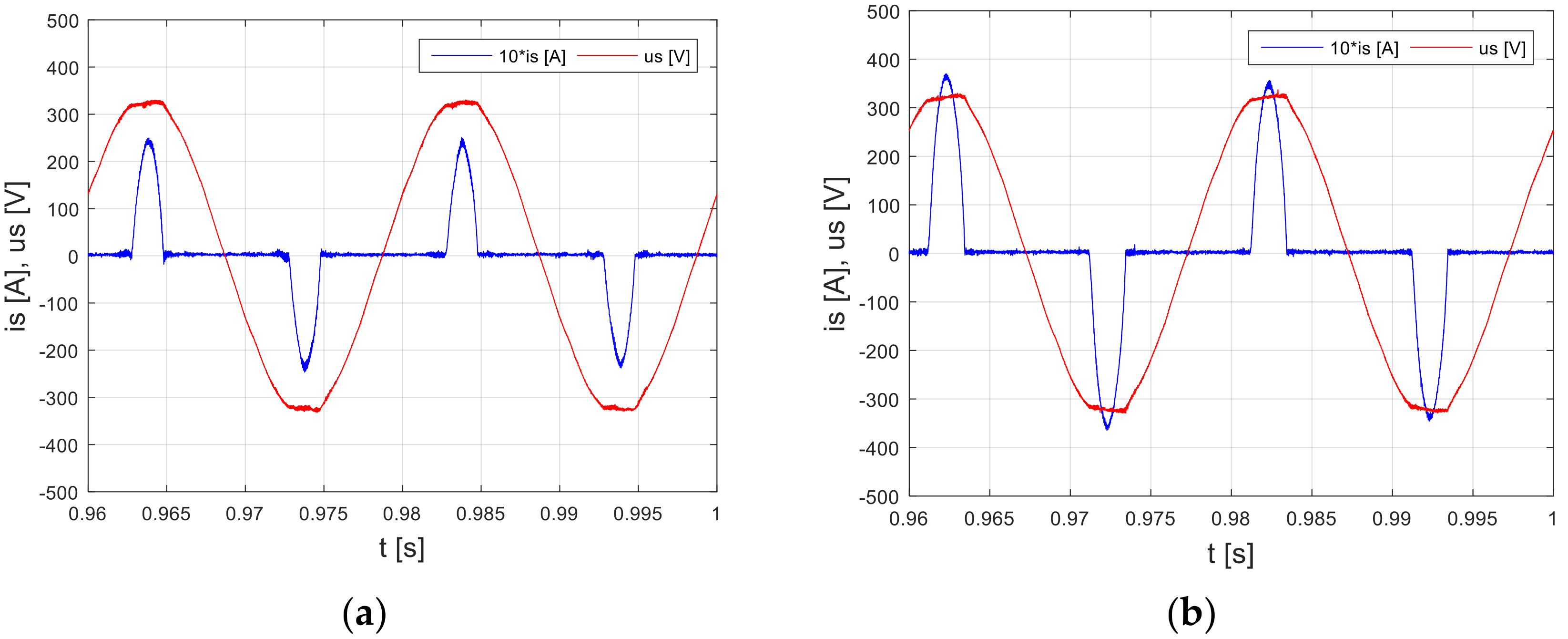


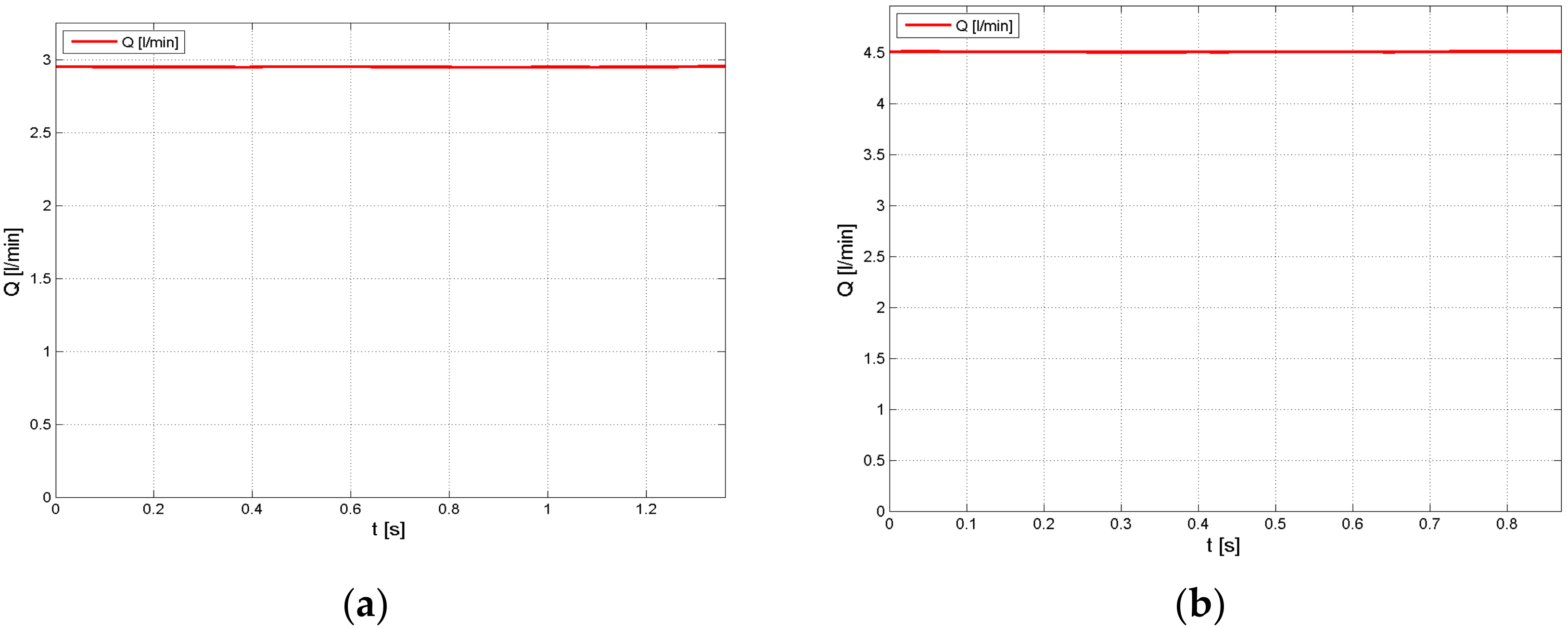

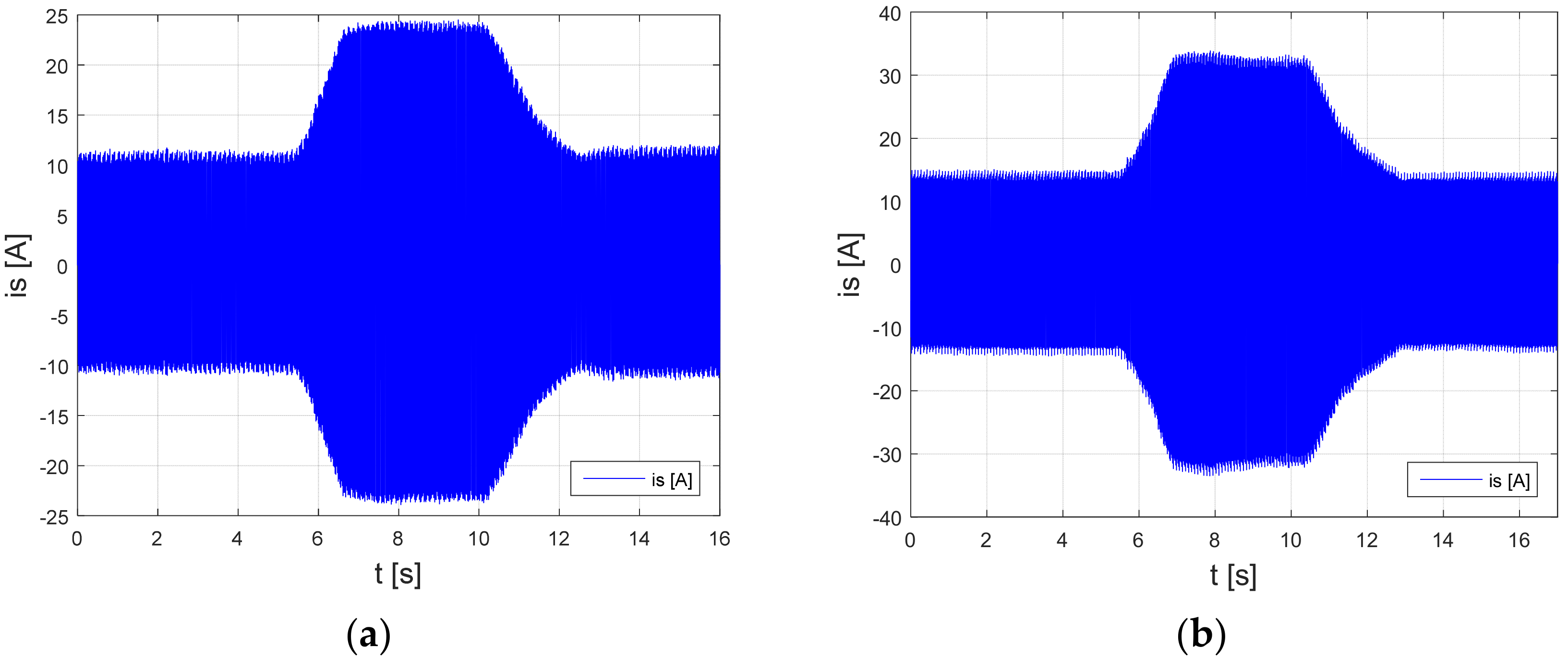
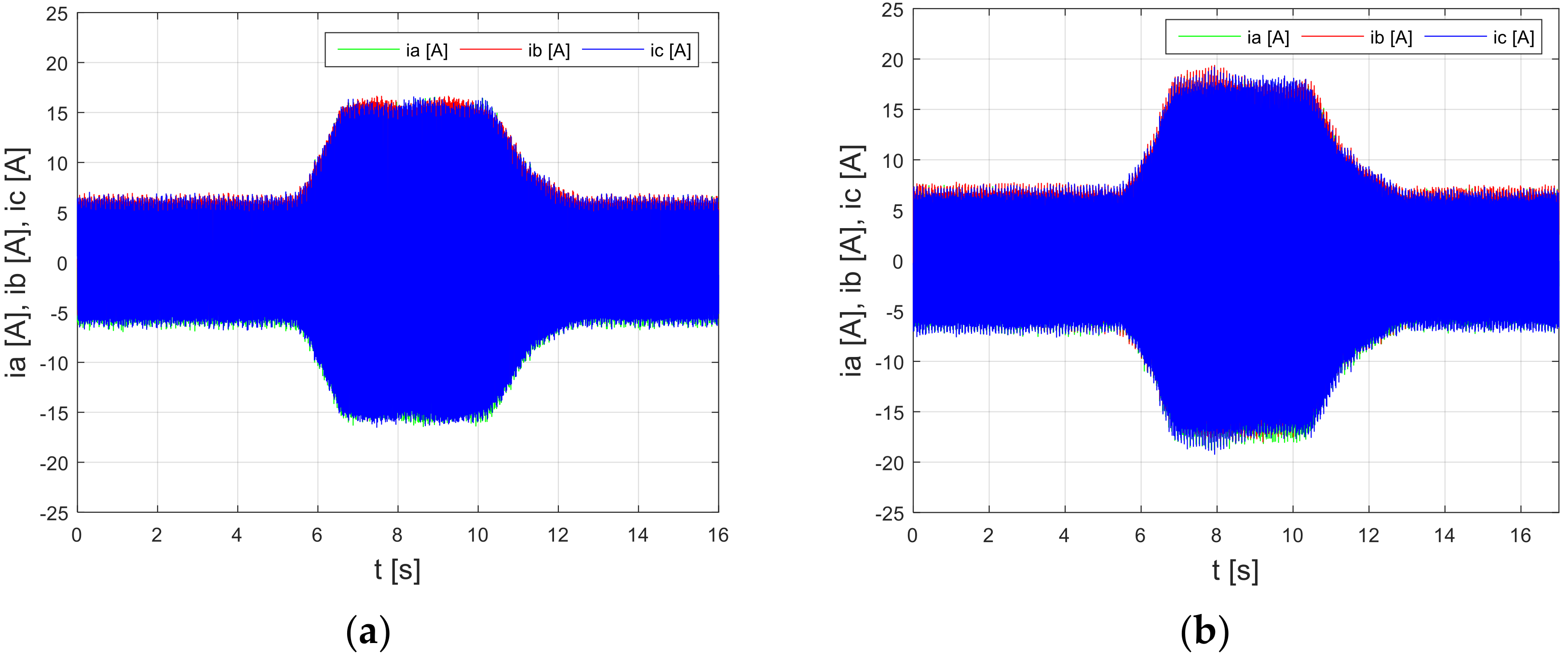
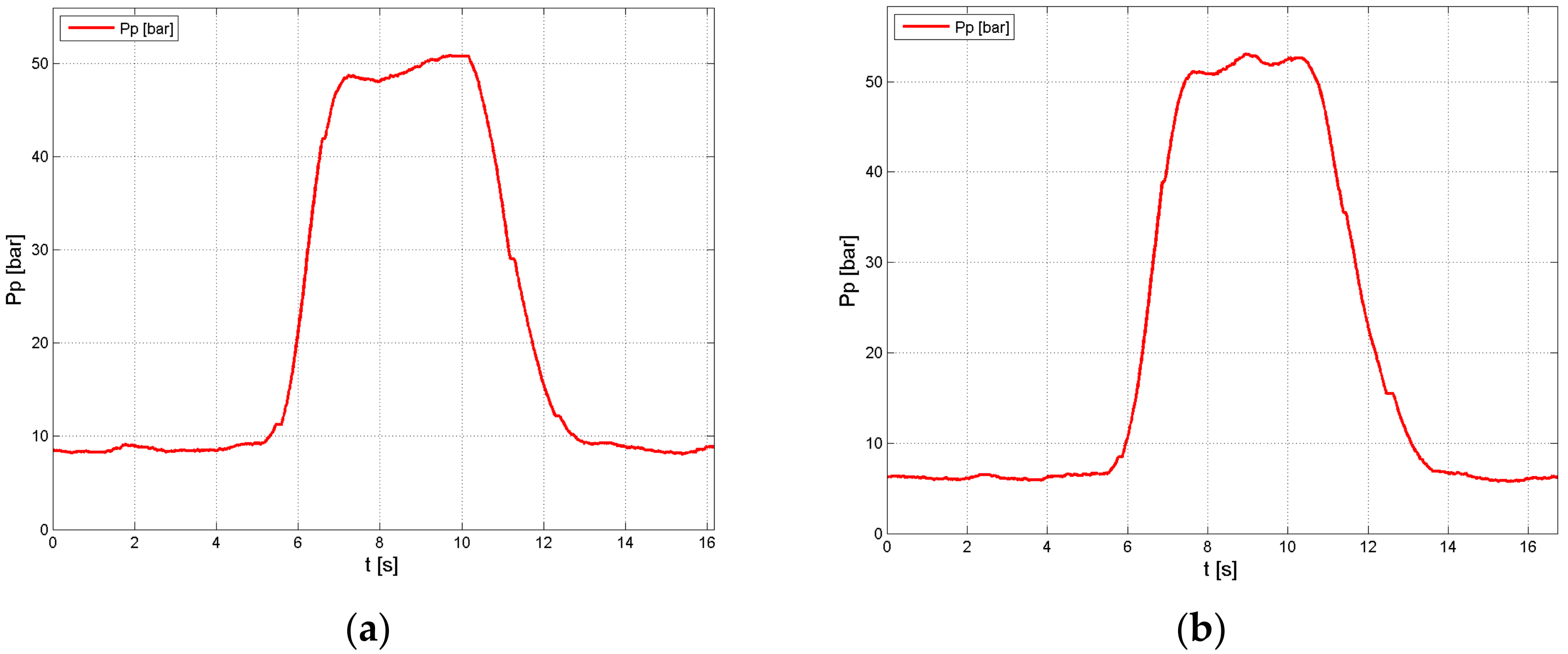

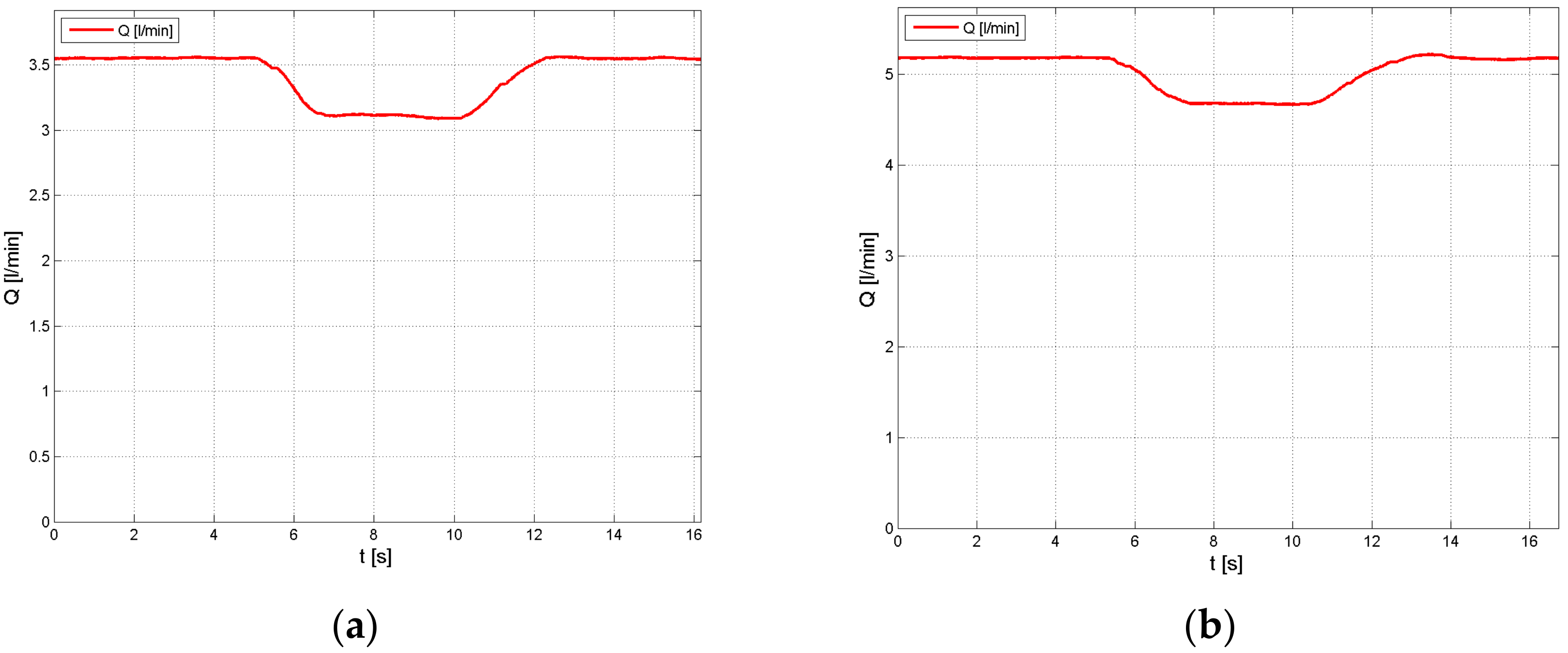

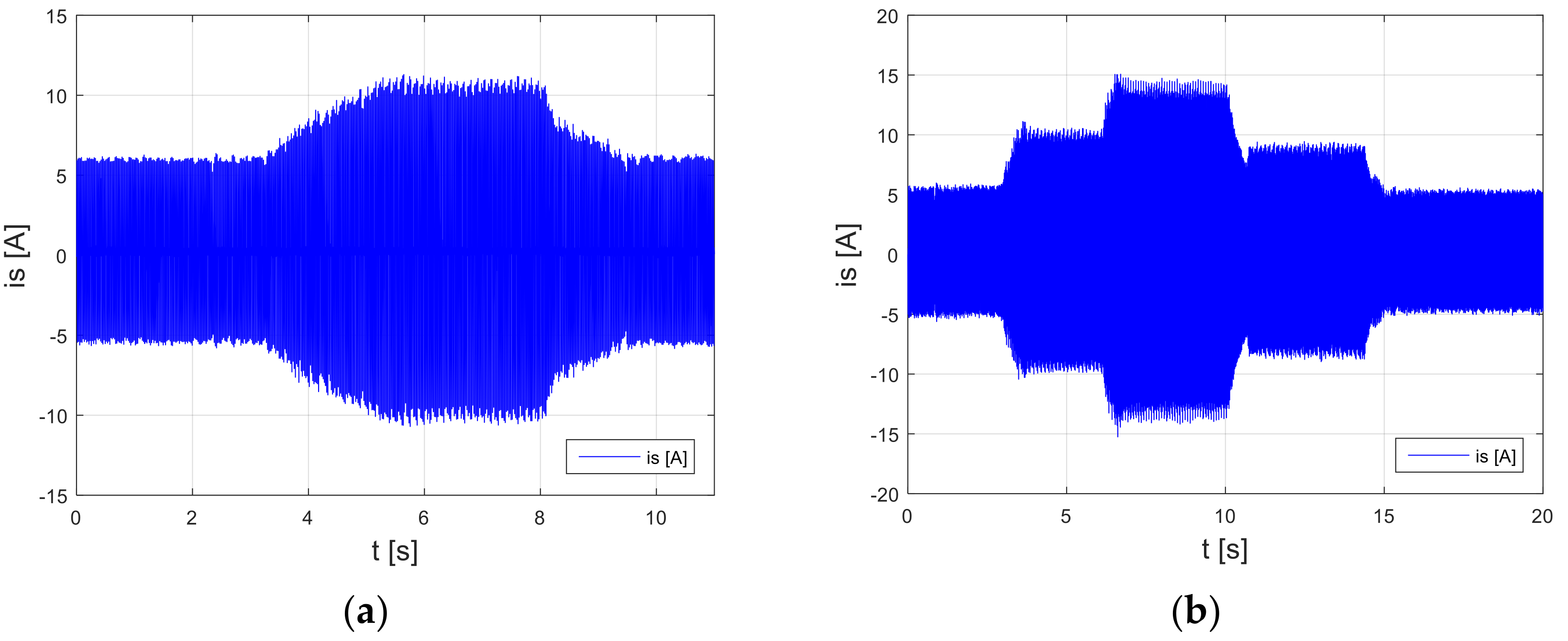


Publisher’s Note: MDPI stays neutral with regard to jurisdictional claims in published maps and institutional affiliations. |
© 2021 by the authors. Licensee MDPI, Basel, Switzerland. This article is an open access article distributed under the terms and conditions of the Creative Commons Attribution (CC BY) license (https://creativecommons.org/licenses/by/4.0/).
Share and Cite
Ciurys, M.P.; Fiebig, W. Experimental Investigation of a Double-Acting Vane Pump with Integrated Electric Drive. Energies 2021, 14, 5949. https://doi.org/10.3390/en14185949
Ciurys MP, Fiebig W. Experimental Investigation of a Double-Acting Vane Pump with Integrated Electric Drive. Energies. 2021; 14(18):5949. https://doi.org/10.3390/en14185949
Chicago/Turabian StyleCiurys, Marek Pawel, and Wieslaw Fiebig. 2021. "Experimental Investigation of a Double-Acting Vane Pump with Integrated Electric Drive" Energies 14, no. 18: 5949. https://doi.org/10.3390/en14185949




